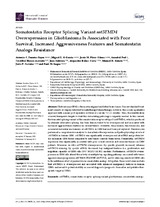Mostrar el registro sencillo del ítem
Somatostatin Receptor Splicing Variant sst5TMD4 Overexpression in Glioblastoma Is Associated with Poor Survival, Increased Aggressiveness Features and Somatostatin Analogs Resistance
| dc.contributor.author | Fuentes-Fayos, Antonio C. | |
| dc.contributor.author | G‐García, Miguel E | |
| dc.contributor.author | Pérez Gómez, J.M. | |
| dc.contributor.author | Peel, Annabel | |
| dc.contributor.author | Blanco‐Acevedo, Cristóbal | |
| dc.contributor.author | Solivera, Juan | |
| dc.contributor.author | Ibáñez-Costa, Alejandro | |
| dc.contributor.author | Gahete Ortiz, Manuel D. | |
| dc.contributor.author | Castaño, Justo P. | |
| dc.contributor.author | Luque, Raúl M. | |
| dc.date.accessioned | 2022-01-21T12:57:35Z | |
| dc.date.available | 2022-01-21T12:57:35Z | |
| dc.date.issued | 2022 | |
| dc.identifier.uri | http://hdl.handle.net/10396/22367 | |
| dc.description.abstract | Glioblastoma (GBM) is the most malignant and lethal brain tumor. Current standard treatment consists of surgery followed by radiotherapy/chemotherapy; however, this is only a palliative approach with a mean post-operative survival of scarcely ~12–15 months. Thus, the identification of novel therapeutic targets to treat this devastating pathology is urgently needed. In this context, the truncated splicing variant of the somatostatin receptor subtype 5 (sst5TMD4), which is produced by aberrant alternative splicing, has been demonstrated to be overexpressed and associated with increased aggressiveness features in several tumors. However, the presence, functional role, and associated molecular mechanisms of sst5TMD4 in GBM have not been yet explored. Therefore, we performed a comprehensive analysis to characterize the expression and pathophysiological role of sst5TMD4 in human GBM. sst5TMD4 was significantly overexpressed (at mRNA and protein levels) in human GBM tissue compared to non-tumor (control) brain tissue. Remarkably, sst5TMD4 expression was significantly associated with poor overall survival and recurrent tumors in GBM patients. Moreover, in vitro sst5TMD4 overexpression (by specific plasmid) increased, whereas sst5TMD4 silencing (by specific siRNA) decreased, key malignant features (i.e., proliferation and migration capacity) of GBM cells (U-87 MG/U-118 MG models). Furthermore, sst5TMD4 overexpression in GBM cells altered the activity of multiple key signaling pathways associated with tumor aggressiveness/progression (AKT/JAK-STAT/NF-κB/TGF-β), and its silencing sensitized GBM cells to the antitumor effect of pasireotide (a somatostatin analog). Altogether, these results demonstrate that sst5TMD4 is overexpressed and associated with enhanced malignancy features in human GBMs and reveal its potential utility as a novel diagnostic/prognostic biomarker and putative therapeutic target in GBMs. | es_ES |
| dc.format.mimetype | application/pdf | es_ES |
| dc.language.iso | eng | es_ES |
| dc.publisher | MDPI | es_ES |
| dc.rights | https://creativecommons.org/licenses/by/4.0/ | es_ES |
| dc.source | International Journal of Molecular Sciences 23(3), 1143 (2022) | es_ES |
| dc.subject | sst5TMD4 | es_ES |
| dc.subject | Somatostatin receptor | es_ES |
| dc.subject | Splicing variant | es_ES |
| dc.subject | Glioblastoma | es_ES |
| dc.subject | Somatostatin analogs | es_ES |
| dc.title | Somatostatin Receptor Splicing Variant sst5TMD4 Overexpression in Glioblastoma Is Associated with Poor Survival, Increased Aggressiveness Features and Somatostatin Analogs Resistance | es_ES |
| dc.type | info:eu-repo/semantics/article | es_ES |
| dc.relation.publisherversion | https://doi.org/10.3390/ijms23031143 | es_ES |
| dc.relation.projectID | Gobierno de España. PID2019‐105564RB‐I00 | es_ES |
| dc.relation.projectID | Gobierno de España. PID2019‐105201RB‐I00 | es_ES |
| dc.relation.projectID | Gobierno de España. FPU16‐ 05059 | es_ES |
| dc.relation.projectID | Gobierno de España. FPU20‐03954 | es_ES |
| dc.relation.projectID | Gobierno de España. FPU18‐06009 | es_ES |
| dc.relation.projectID | Instituto de Salud Carlos III. CD19/00255 | es_ES |
| dc.relation.projectID | Junta de Andalucía. BIO‐0139 | es_ES |
| dc.relation.projectID | Junta de Andalucía. P20_00442 | es_ES |
| dc.relation.projectID | Junta de Andalucía. PEER‐0048‐2020 | es_ES |
| dc.rights.accessRights | info:eu-repo/semantics/openAccess | es_ES |

